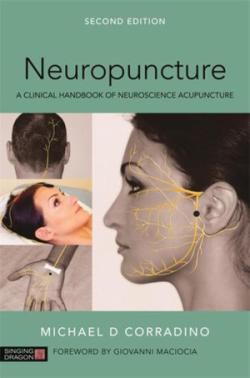Acupuncture - Neuropuncture
Locatie/Venue
Inleiding/Introduction
Neuroscience Acupuncture
Introduction
Neuropuncture is the clinical manual of a groundbreaking acupuncture system that incorporates neuroscience into its clinical applications for pain management, orthopaedic conditions and internal medicine. It shows acupuncturists how to apply research into the neurophysiological mechanisms of acupuncture and electrical acupuncture to the traditional TCM model of healthcare

- 5 Neurophysiological mechanisms
- 5 Neuropuncture Treatment Principles
- 5 Neuropuncture Electrical Techniques
- Point location
- Needle technique
- Neuropuncture Assessment
- Neuropuncture point prescription
- Neuropuncture dosage
- Treatment plan
- Past
- Current
- Future
- Pain management / Orthopedic Neuropuncture treatment prescriptions:
- Sciatica HNP (herniated nucleus prolapse) with radiculopathy
- Cervical HNP with radiculopathy
- Carpal Tunnel Syndrome (CTS)
- Knee pain: Meniscus and collateral ligaments
- Mental health Neuropuncture clinical treatment prescriptions:
- Clinical Depression
- Insomnia
- Tinnitus
- Hypertension
- Diabetes Type II
- Immune Support
Auricular Neuropuncture:
- Ear neuroscience
- ASP
- Auricular Ear
- Practice and Demonstration
- Protocols
Neuropuncture Body and Auricular Treatment Protocols combined:
- Practice and Demonstration
Neuropuncture Tui Na - Traditional Chinese Bone Setting:
- Cervical Spine
- Anatomy and physiology of cervical spine and upper back including muscles, ligaments and tendons, nerves, and bones.
- Traction
- Rotation
Video
Inhoud/Content
-
Toelatingsvoorwaarden - Condition of admission: acupuncture diploma
-
Voertaal - Language : English
-
Location - location : campus (Antwerp - Belgium)
-
Lesdatum - Dates: 01 - 02 - 03 March 2019
-
Dagindeling - Timing :
-
Vrijdag - Friday : 14.00 - 21.00 h
-
Zaterdag - Saturday : 09.00 - 18.30 h
-
Zondag - Sunday : 09.00 - 14.30 h
-
-
Aantal cursisten: minimum 10 - max 30
-
Cursusgeld - Fee : 500 € (download syllabus / file)
-
Accreditatie : VNT - NWP - NVA - EUFOM - BAF - ZHONG
-
Deelnemers uit het Vlaamse gewest kunnen gebruik maken van de KMO-portefeuille. De kmo-portefeuille is een maatregel waardoor ondernemers financiële steun krijgen bij aankoop van opleiding (mogelijkheid tot maximum 40% tussenkomst van de Vlaamse Gemeenschap)
-
De organisatie behoudt zich het recht voor om eventuele wijzigingen in het programma en planning aan te brengen.
Teacher
Corradino Michaël
|
 |
Accreditaties/Accreditation
Het aantal accreditatiepunten verschilt per beroepsverenging en wordt best nagezien bij de betreffende organisatie
BAF, EUFOM , NVA , NWP , ZHONG
Studiepunten/Credits
1.5 = Een studiepunt is een binnen de Vlaamse Gemeenschap aanvaarde internationale eenheid die overeenstemt met ten minste 25 en ten hoogste 30 uren voorgeschreven onderwijs-, leer- en examenactiviteiten en waarmee de studiebelasting van elke opleiding of elk opleidingsonderdeel wordt uitgedrukt
Cursusgeld/Fee
500
KMO-P
Kom je in aanmerking? zie https://www.iczo.be/nl/kmo-portefeuille
Studiegebied
Traditional Chinese Medicine Oosterse Gezondheidszorg
Voertaal/Language
English
